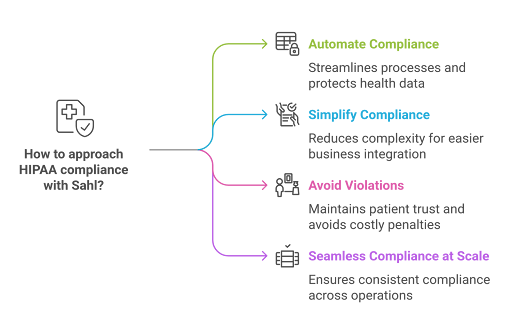Mandates the safeguarding of protected health information (PHI) by organizations to ensure its confidentiality and security
Most teams rely on fragmented tools and spreadsheets to track HIPAA requirements. Sahl replaces that complexity with one system that brings real visibility to your compliance efforts.
Built for small teams and fast-moving healthcare organizations.

HIPAA compliance is not just a legal requirement. It is a direct reflection of how seriously your organization treats patient trust. When policies are incomplete, or controls are not enforced, the consequences go beyond fines. They affect your credibility, your partnerships, and your ability to grow.
Sahl gives you the tools to prevent that risk from becoming a reality. Instead of reacting when issues surface, your team gains the visibility to act early and stay ahead.

Whether you are preparing for your first HIPAA audit or addressing existing compliance gaps, our team can help you build a clear, structured plan. There is no jargon or guesswork, just a practical review tailored to your organization’s operations.
HIPAA compliance means meeting the standards set by the Health Insurance Portability and Accountability Act for protecting personal health information. It requires organizations to implement policies, controls, and procedures to safeguard health records from unauthorized access, misuse, or disclosure.
The primary purpose of HIPAA is to protect patient privacy and ensure that health data is handled securely across systems and service providers. It also establishes rights for individuals to control how their health information is accessed and shared.
HIPAA compliance includes administrative, physical, and technical safeguards. This covers access management, employee training, risk assessments, documentation, breach reporting, and ongoing monitoring of systems that handle protected health information.
HIPAA focuses specifically on healthcare-related data protection in the United States, while GDPR applies to all personal data in the European Union. HIPAA regulates hospitals, clinics, insurers, and healthcare vendors, while GDPR applies to any business that processes EU citizens’ data. Sahl helps teams navigate both where applicable, especially in cross-border or multi-framework environments.
A HIPAA compliance tool is a software platform that helps organizations meet HIPAA requirements. It supports policy tracking, audit preparation, staff training logs, risk assessments, and evidence management. Sahl offers these capabilities in a single, structured system for growing healthcare teams.
Costs depend on your current systems, team size, and internal resources. The right platform can manage costs affordably for smaller clinics or digital health startups. Sahl helps reduce cost and effort by centralizing key HIPAA functions so smaller teams can stay compliant without needing a large internal department.
You can use Sahl to assign and track HIPAA controls, store your documentation, manage employee training, and monitor access to sensitive data. The platform provides visibility into what is working, what is missing, and what needs action to maintain compliance.
In the United States, HIPAA is enforced by the Office for Civil Rights under the Department of Health and Human Services. While Sahl supports global compliance needs, it helps organizations align with HIPAA by giving them the structure and tools needed to demonstrate control and readiness.
